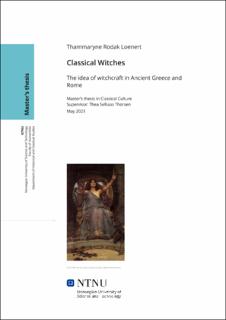| dc.contributor.advisor | Thorsen, Thea Selliaas | |
| dc.contributor.author | Rodak Loenert, Thammaryne | |
| dc.date.accessioned | 2023-07-04T17:25:00Z | |
| dc.date.available | 2023-07-04T17:25:00Z | |
| dc.date.issued | 2023 | |
| dc.identifier | no.ntnu:inspera:144951629:97804328 | |
| dc.identifier.uri | https://hdl.handle.net/11250/3075927 | |
| dc.description.abstract | Denne oppgaven undersøker ideen om heksekunst i antikken, hvordan det kan defineres, hvordan det ble til, samt hvordan det differensierte seg fra andre religiøse praksiser. Disse praksisene blir sammenlignet med kristne ideer og begreper og blir undersøkt i henholdt til hvordan de kan ha påvirket hverandre. Basert på dette er det mulig å undersøke hva som ble ansett som nødvendig for å bli regnet som en heks, samt hva de vanligste praksisene til profesjonelle og amatører var basert på hva som kommer til utrykk i tekster og gjenstander som har overlevd til vår tid.
Kjente figurer fra litteraturen, som Medea og Circe, blir også presentert og danner grunnlaget for en diskusjon om hva som gjorde dem til kjente hekser og hvordan vi kan bruke litteratur til å lære om fortiden. Dette er figurer som var med på å forme ideen om hva en heks var gjennom århundrer. Derfor er det viktig å stille spørsmål ved om de også var like sterkt ansett som hekser i antikken eller om nyere ideer har endret måten vi vurderer dem. Ved å gjøre dette lar det oss besvare om vi kan lære noe fra deres historier når det kommer til antikkens samfunn, og hva de kan fortelle oss om forståelsen av heksekunst i antikken.
Denne oppgaven viser at alle de forskjellige aspektene rundt hekseri var subjektive. Definisjonen, kriteriene og hva som skilte det fra religion og vitenskap varierte ut ifra hvem som er i søkelyset, og ut ifra hvilken tidsperiode som blir undersøkt. Å gi en klar definisjon av hva heksekunst var er derfor vanskelig å gjøre, noe andre forskere også har konkludert med. Denne oppgaven bidrar derfor til den faglige diskusjonen om heksekunst ved å presentere et synoptisk syn på hvordan heksekunst i antikken ble forstått. | |
| dc.description.abstract | This thesis investigates the idea of witchcraft in antiquity, how it can be defined and how it came to be, and how it deviated from other religious beliefs. These practices are compared with certain Christian beliefs and concepts and examines how they might have influenced one another. From this it is possible to examine what criteria were considered valid for one to be regarded as a witch, and what the common practices of professionals and amateurs were, from what we can gather out of texts and objects that have survived to our day.
Famous figures in literature, such as Medea and Circe, are also presented and form the basis of a discussion around what made them famous witches and how we can use literature to learn more about history. These are figures that helped shape the concept of what a witch was for centuries; it is therefore important to ask the question of whether they were as noteworthy as witches in Antiquity or if our ideals have altered the way we see them. Doing so helps us answer the question of whether we can learn anything from their stories when it comes to ancient societies, and what they can tell us about the understanding of witchcraft in antiquity.
This thesis shows that all the different facets regarding witchcraft were subjective. The definition, criteria and what separates it from religion and science varied according to who one is inquiring about, and at what point in history we are looking at. Giving one clear definition of what witchcraft was is therefore hard to do, as other scholars have also concluded. I have, however, presentedThis thesis therefore contributes to the scholarly discussion of witchcraft by presenting different aspects of it, so one can have a synoptical view of what witchcraft in ancient times was understood as. | |
| dc.language | eng | |
| dc.publisher | NTNU | |
| dc.title | Classical Witches
The idea of witchcraft in Ancient Greece and Rome | |
| dc.type | Master thesis | |
